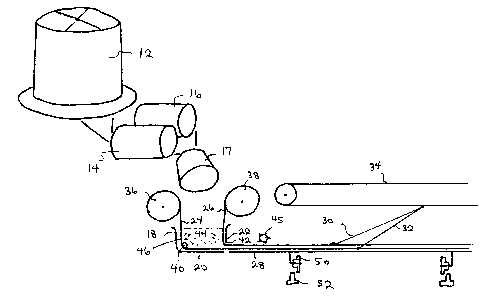Une partie des informations de ce site Web a été fournie par des sources externes. Le gouvernement du Canada n'assume aucune responsabilité concernant la précision, l'actualité ou la fiabilité des informations fournies par les sources externes. Les utilisateurs qui désirent employer cette information devraient consulter directement la source des informations. Le contenu fourni par les sources externes n'est pas assujetti aux exigences sur les langues officielles, la protection des renseignements personnels et l'accessibilité.
L'apparition de différences dans le texte et l'image des Revendications et de l'Abrégé dépend du moment auquel le document est publié. Les textes des Revendications et de l'Abrégé sont affichés :
| (12) Brevet: | (11) CA 2146216 |
|---|---|
| (54) Titre français: | PROCEDE DE FABRICATION DE MATERIAUX CIMENTAIRES CELLULAIRES RENFORCES DE FIBRES, POUR LE BATIMENT |
| (54) Titre anglais: | PROCESS FOR MAKING FIBRE REINFORCED CELLULAR CEMENTIOUS BUILDING MATERIALS |
| Statut: | Périmé et au-delà du délai pour l’annulation |
| (51) Classification internationale des brevets (CIB): |
|
|---|---|
| (72) Inventeurs : |
|
| (73) Titulaires : |
|
| (71) Demandeurs : |
|
| (74) Agent: | THOMPSON LAMBERT LLP |
| (74) Co-agent: | |
| (45) Délivré: | 2001-08-14 |
| (22) Date de dépôt: | 1995-04-03 |
| (41) Mise à la disponibilité du public: | 1996-10-04 |
| Requête d'examen: | 1995-12-08 |
| Licence disponible: | S.O. |
| Cédé au domaine public: | S.O. |
| (25) Langue des documents déposés: | Anglais |
| Traité de coopération en matière de brevets (PCT): | Non |
|---|
| (30) Données de priorité de la demande: | S.O. |
|---|
A process for making fibre reinforced cellular cementious
building materials. Firstly, mix separately a foam slurry and
a cementious mixture containing water and random glass fibres.
Secondly, combine the foam slurry with the cementious mixture
in a container to form a cellular cementious slurry containing
random glass fibres. The container has a bottom with an
orifice positioned adjacent the bottom. Thirdly, pull two
parallel spaced layers of integrally formed glass fibre
reinforcing mesh through the mixing container filled with
cellular cementious slurry and out through the orifice into a
drying tray. As the reinforcing mesh passes through the mixing
container it pulls along with it cellular cementious slurry.
The orifice restricts the amount of cellular cementious slurry
that is drawn into the drying tray, thereby serving to gauge
the dimensions of the building material. Fourthly leave the
cellular cementious slurry to cure in the drying tray until the
cellular cementious slurry has set thereby resulting in a
cellular cementious building material having two reinforcing
layers of integrally formed glass fibre mesh with random glass
fibres extending between the two layers of integrally formed
glass fibre mesh.
Note : Les revendications sont présentées dans la langue officielle dans laquelle elles ont été soumises.
Note : Les descriptions sont présentées dans la langue officielle dans laquelle elles ont été soumises.

2024-08-01 : Dans le cadre de la transition vers les Brevets de nouvelle génération (BNG), la base de données sur les brevets canadiens (BDBC) contient désormais un Historique d'événement plus détaillé, qui reproduit le Journal des événements de notre nouvelle solution interne.
Veuillez noter que les événements débutant par « Inactive : » se réfèrent à des événements qui ne sont plus utilisés dans notre nouvelle solution interne.
Pour une meilleure compréhension de l'état de la demande ou brevet qui figure sur cette page, la rubrique Mise en garde , et les descriptions de Brevet , Historique d'événement , Taxes périodiques et Historique des paiements devraient être consultées.
| Description | Date |
|---|---|
| Lettre envoyée | 2006-04-18 |
| Inactive : Lettre officielle | 2006-02-22 |
| Le délai pour l'annulation est expiré | 2004-04-05 |
| Lettre envoyée | 2003-04-03 |
| Accordé par délivrance | 2001-08-14 |
| Inactive : Page couverture publiée | 2001-08-13 |
| Préoctroi | 2001-05-09 |
| Inactive : Taxe finale reçue | 2001-05-09 |
| Un avis d'acceptation est envoyé | 2000-11-23 |
| Un avis d'acceptation est envoyé | 2000-11-23 |
| Lettre envoyée | 2000-11-23 |
| Inactive : Approuvée aux fins d'acceptation (AFA) | 2000-11-06 |
| Modification reçue - modification volontaire | 1999-10-15 |
| Inactive : Dem. de l'examinateur par.30(2) Règles | 1999-04-15 |
| Inactive : CIB attribuée | 1999-03-26 |
| Inactive : Renseign. sur l'état - Complets dès date d'ent. journ. | 1997-12-19 |
| Inactive : Dem. traitée sur TS dès date d'ent. journal | 1997-12-19 |
| Demande publiée (accessible au public) | 1996-10-04 |
| Toutes les exigences pour l'examen - jugée conforme | 1995-12-08 |
| Exigences pour une requête d'examen - jugée conforme | 1995-12-08 |
Il n'y a pas d'historique d'abandonnement
Le dernier paiement a été reçu le 2001-04-02
Avis : Si le paiement en totalité n'a pas été reçu au plus tard à la date indiquée, une taxe supplémentaire peut être imposée, soit une des taxes suivantes :
Veuillez vous référer à la page web des taxes sur les brevets de l'OPIC pour voir tous les montants actuels des taxes.
| Type de taxes | Anniversaire | Échéance | Date payée |
|---|---|---|---|
| Requête d'examen - petite | 1995-12-08 | ||
| TM (demande, 3e anniv.) - petite | 03 | 1998-04-03 | 1998-03-27 |
| TM (demande, 4e anniv.) - petite | 04 | 1999-04-05 | 1999-01-20 |
| TM (demande, 5e anniv.) - petite | 05 | 2000-04-03 | 2000-01-10 |
| TM (demande, 6e anniv.) - petite | 06 | 2001-04-03 | 2001-04-02 |
| Taxe finale - petite | 2001-05-09 | ||
| TM (brevet, 7e anniv.) - petite | 2002-04-03 | 2002-01-21 |
Les titulaires actuels et antérieures au dossier sont affichés en ordre alphabétique.
| Titulaires actuels au dossier |
|---|
| RAMSAY BELLINGHAM |
| Titulaires antérieures au dossier |
|---|
| S.O. |